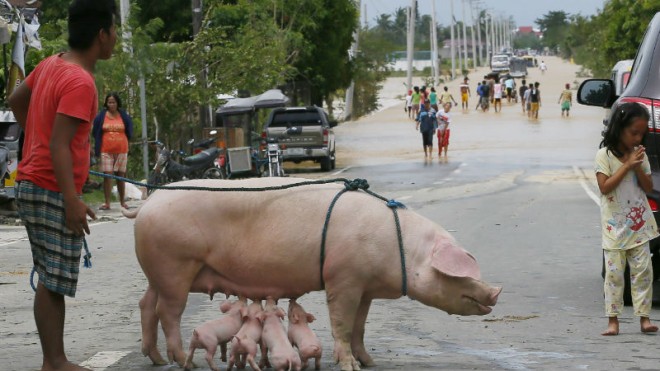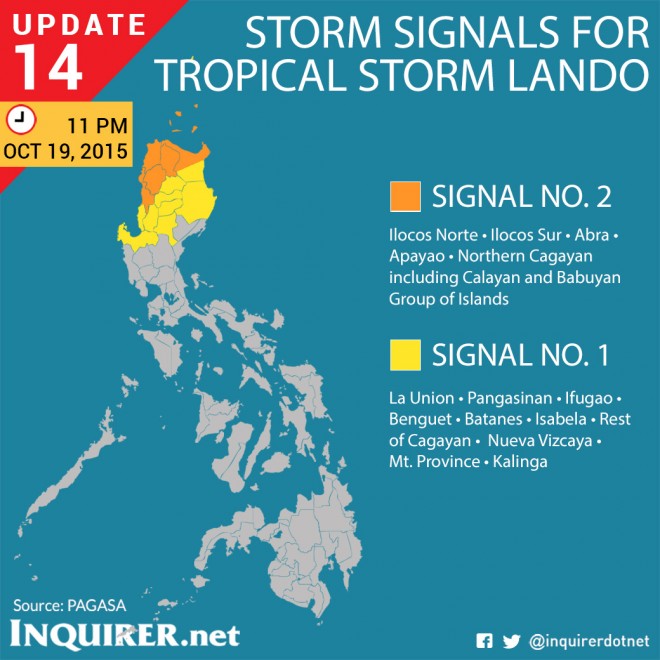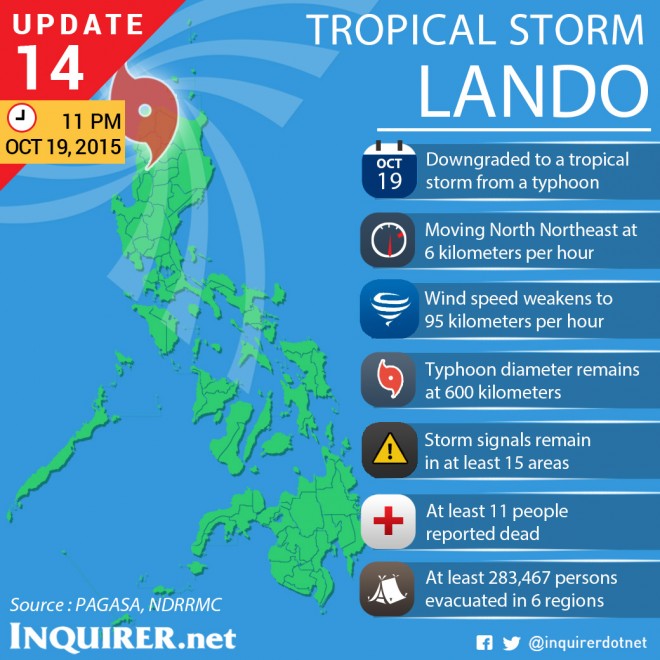‘Lando’ further weakens as it leaves Ilocos Norte landmass
TROPICAL storm “Lando” (International name Koppu) has further weakened as it exited the landmass of Ilocos Norte, the Philippine Atmospheric, Geophysical and Astronomical Services Administration (Pagasa) said late Monday night.
In its 11:00 p.m. bulletin, Pagasa said the storm’s location as of 10 p.m. Monday was plotted 45 kilometers west northwest of Laoag City, Ilocos Norte (coordinates:18.4°N, 119.6°E).
Lando has maximum sustained winds of 95 kph near the center and gustiness of up to 120 kph, moving north northeast at 6 kph.
By Tuesday night, Lando’s location is forecast at 115 km west of Calayan, Cagayan, and on Wednesday at 90 km Southwest of Itbayat, Batanes.
Army, police and civilian volunteers rushed Monday to rescue hundreds of villagers trapped in their flooded homes and on rooftops in Nueva Ecija battered by slow-moving storm.
The typhoon blew ashore into northeastern Aurora province with fierce wind and heavy rains early Sunday, leaving at least 11 dead, forcing more than 65,000 villagers from their homes, and leaving nine provinces without electricity. The typhoon weakened once on land, and by Monday afternoon, Lando had weakened into a tropical storm over Ilocos Norte province with winds of 105 kilometers (65 miles) per hour and gusts of up to 135 kph (84 mph).
Several of the affected provinces, led by Nueva Ecija, were inundated by flash floods that swelled rivers and cascaded down mountains, trapping villagers in their homes, said Nigel Lontoc of the Office of Civil Defense.
“There were people who got trapped by the flood on their roofs, some were rescued already,” Vice Mayor Henry Velarde of Nueva Ecija’s Jaen town told The Associated Press by telephone, adding that about 80 percent of 27 villages in his farming town of more than 45,000 people were inundated by flood.

A sow nurses her piglets after being evacuated to safety following the flooding brought about by Typhoon Koppu at Zaragosa township, Nueva Ecija province, north of Manila, Philippines Monday, Oct. 19, 2015. Slow-moving Typhoon Koppu blew ashore with fierce wind in the northeastern Philippines early Sunday, toppling trees and knocking out power and communications and forcing the evacuation of thousands of villagers.(AP Photo/Bullit Marquez)
When a major river flooded and swamped the villages, residents scrambled to safety but many failed to save their poultry and farm animals. Out of more than 5,000 ducks, for example, only about 1,000 were saved and many rice crops ready to be harvested in a few weeks turned into a muddy waste, he said.
“Our rice farms looked like it was ran over by a giant flat iron,” Velarde said. “All the rice stalks were flattened in one direction.”
Hundreds of soldiers, police and volunteers have converged on Nueva Ecija, a landlocked, rice-growing province in the heart of Luzon Island, to help villagers whose homes had been flooded, said Lontoc.
Erwin Jacinto, a 37-year-old resident of Nueva Ecija’s Santa Rosa town, said the flooding turned his farmland into “nothing but mud.”
Jacinto spoke from atop a high bridge that juts out from his flooded town and where dozens of farming villagers like him stayed in the open overnight with their families, and their pigs, goats and chickens.
Lando’s winds knocked down trees and electric posts, forced the suspension of dozens of flights and sea voyages, and the cancellation of classes in schools.
At least 11 people died, mostly due to drownings, landslides and fallen trees. One man was buried by a landslide while checking his farm on Sunday in the mountain town of Bakun in Benguet province. Two men drowned in Nueva Ecija, while a 14-year-old boy was killed when a huge branch of a tree fell on his family’s shanty in Quezon City.
Seven people died when a passenger motorboat capsized in bad weather in the central Philippines, but the government’s disaster-response agency has not included the deaths in the typhoon toll because the central region was not directly affected by the storm.
President Benigno Aquino III and disaster-response agencies had warned that Lando’s rain and winds may potentially bring more damage with its slow speed. But government forecasters said that there was less heavy rain than expected initially in some areas, including in Manila, but that fierce winds lashed many regions.
















